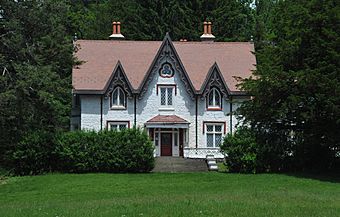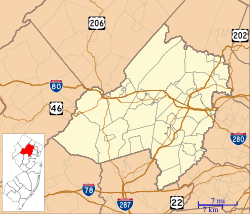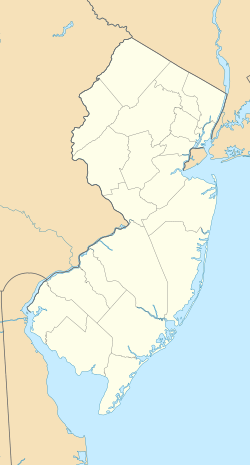Tempe Wick Road–Washington Corners Historic District facts for kids
|
Tempe Wick Road–Washington Corners Historic District
|
|
 |
|
| Location | Corey Lane, Cemetery Road, Tempe Wick, Kennaday, Leddell, and Jockey Hollow Road Harding Mendham Township Morris County, New Jersey |
|---|---|
| Area | 237.2 acres (96.0 ha) |
| Architect | Multiple |
| NRHP reference No. | 00000959 |
Quick facts for kids Significant dates |
|
| Added to NRHP | August 25, 2008 |
The Tempe Wick Road–Washington Corners Historic District is a special area in Harding and Mendham Township, New Jersey. It's a place where many old buildings and landscapes are protected because they are important to history. This district includes Tempe Wick Road and parts of several other roads nearby. The main road is named after a person called Temperance Wick.
Contents
What is the Tempe Wick Road–Washington Corners Historic District?
This historic district is a large area that covers about 237 acres. It was officially recognized as important in 2008. The district includes Tempe Wick Road, from US Route 202 to Cold Hill Road. It also has small parts of Corey Lane, Cemetery Road, Kenneday Road, Leddell Road, and Jockey Hollow Road. These roads connect different historic sites within the district.
Why is this Area Important?
The Tempe Wick Road–Washington Corners Historic District is important because it shows how people lived a long time ago. It has many old buildings and farms that tell a story about the past. These places help us understand the history of New Jersey and the United States.
Who Was Temperance Wick?
The main road in the district, Tempe Wick Road, is named after Temperance Wick. She was a real person who lived in this area during the time of the American Revolutionary War. Her family's farm, known as the Wick House, is a famous part of the nearby Jockey Hollow area. Jockey Hollow was a winter camp for the Continental Army during the war.
Protecting Historic Places
Historic districts like this one are created to protect old buildings and landscapes. This helps make sure these important places are saved for future generations. It means that any changes to the buildings or land must follow special rules. This helps keep the historical look and feel of the area.
How are Historic Districts Chosen?
For an area to become a historic district, it needs to have a lot of buildings or sites that are old and special. These places must show important parts of history, architecture, or culture. Experts study the area and its history very carefully. If it meets the rules, it can be added to lists like the National Register of Historic Places.




